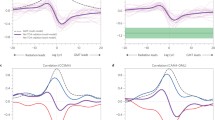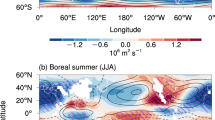Abstract
Changes in Heat Index (a combined measure of temperature and humidity) associated with global warming are evaluated based on the output from four extended integrations of the GFDL coupled ocean-atmosphere climate model. The four integrations are: a control with constant levels of atmospheric carbon dioxide (CO2), a second integration in which an estimate of the combined radiative forcing of greenhouse gases and sulfate aerosols over the period 1765–2065 is used to force the model, and a third (fourth) integration in which atmospheric CO2$ increases at the rate of 1% per year to double (quadruple) its initial value, and is held constant thereafter. While the spatial patterns of the changes in Heat Index are largely determined by the changes in surface air temperature, increases in atmospheric moisture can substantially amplify the changes in Heat Index over regions which are warm and humid in the Control integration. The regions most prone to this effect include humid regions of the Tropics and summer hemisphere extra-tropics, including the southeastern United States, India, southeast Asia and northern Australia.
Similar content being viewed by others
References
Gaffen, D. J. and Ross, R. J.: 1998, ‘Increased Summertime Heat Stress in the U.S.’, Nature 396, 529–530.
Haywood, J. M., Stouffer, R. J., Wetherald, R. T., Manabe, S., and Ramaswamy, V: 1997, ‘Transient Response of a Coupled Model to Estimated Changes in Greenhouse Gas and Sulfate Concentrations’, Geophys. Res. Lett. 24, 1335–1338.
Kalkstein, L. S. and Smoyer, K. E.: 1993, ‘The Impact of Climate Change on Human Health: Some International Implications’, Experientia 49, 969–979.
Kattenberg, A., Giorgi, F., Grassl, H., Meehl, G. A., Mitchell, J. F. B., Stouffer, R. J., Tokioka, T., Weaver, A. J., and Wigley, T. M. L.: 1995, ‘Climate Models — Projections of Future Climate’, in Climate Change 1995 — The Science of Climate Change, Chapter 6, Cambridge University Press.
Manabe, S. and Stouffer, R. J.: 1994, ‘Multiple-Century Response of a Coupled Ocean-Atmosphere Model to an Increase of Atmospheric Carbon Dioxide’, J. Climate 7, 5–23.
Santer, B. D., Wigley, T. M. L., Barnett, T. P., and Anyamba, E.: 1995, ‘Detection of Climate Change and Attribution of Causes’, in Climate Change 1995 — The Science of Climate Change, Chapter 8, Cambridge University Press.
Steadman, R. G.: 1979, ‘The Assessment of Sultriness. Part I: A Temperature-Humidity Index Based on Human Physiology and Clothing Science’, J. Appl. Meteorol. 18, 861–873.
Steadman, R. G.: 1984, ‘A Universal Scale of Apparent Temperature’, J. Clim. Appl. Meteorol. 23, 1674–1687.
Steadman, R. G.: 1994, ‘Norms of Apparent Temperature in Australia’, Aust. Met. Mag. 43, 1–16.
Stone, R.: 1995, ‘If the Mercury Soars, So May Health Hazards’, Sci. News Comments 267, 957–958.
Warrick, R. A., Le Provost, C., Meier, M. F., Oerlemans, J., and Woodworth, P. L.: 1995, ‘Changes in Sea Level’, in Climate Change 1995 — The Science of Climate Change, Chapter 7, Cambridge University Press.
Wetherald, R. and Manabe, S.: 1995, ‘The Mechanisms of Summer Drying Induced by Greenhouse Warming’, J. Climate 8, 3096–3108.
Author information
Authors and Affiliations
Rights and permissions
About this article
Cite this article
Delworth, T.L., Mahlman, J.D. & Knutson, T.R. Changes in Heat Index Associated with CO2-Induced Global Warming. Climatic Change 43, 369–386 (1999). https://doi.org/10.1023/A:1005463917086
Issue Date:
DOI: https://doi.org/10.1023/A:1005463917086




